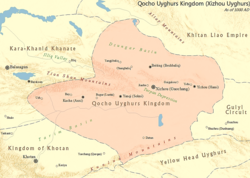
Back Qarahoca uyğur idıkutluğu AZ Reich von Kocho German Reino Uigur de Qocho Spanish پادشاهی قرهخواجه FA Royaume ouïghour de Qocho French Kerajaan Qocho ID 天山ウイグル王国 Japanese 고창회골 Korean Karachodžos karalystė LT Кочо (уйгурское государство) Russian
Qocho Kingdom 高昌回鶻 | |||||||||||||
|---|---|---|---|---|---|---|---|---|---|---|---|---|---|
| 843–14th century | |||||||||||||
 Territory of Qocho c. 1000. | |||||||||||||
| Status |
| ||||||||||||
| Capital | Gaochang (Qocho), Beshbalik (Beiting/Tingzhou) | ||||||||||||
| Common languages | Old Uyghur, Middle Chinese; also Tocharian and Sogdian in early years | ||||||||||||
| Religion | Manichaeism (official initially 843–965),[1][2] Buddhism (Later declared as official)[3] Church of the East | ||||||||||||
| Government | Monarchy | ||||||||||||
| Idiqut | |||||||||||||
| History | |||||||||||||
• Established | 843 | ||||||||||||
• Disestablished | 14th century | ||||||||||||
| |||||||||||||
| Today part of | |||||||||||||

Qocho or Kara-Khoja (Chinese: 高昌回鶻; pinyin: Gāochāng Huíhú; lit. 'Gaochang Uyghurs'),[4] also known as Idiqut,[5][6][7][8] ("holy wealth"; "glory"; "lord of fortune"[9]) was a Uyghur kingdom created in 843, with strong Chinese Buddhist and Tocharian influences. It was founded by refugees fleeing the destruction of the Uyghur Khaganate after being driven out by the Yenisei Kirghiz. They made their winter capital in Qocho (also called Gaochang or Qara-Khoja, near modern Turpan) and summer capital in Beshbalik (modern Jimsar County, also known as Tingzhou).[10] Its population is referred to as the "Xizhou Uyghurs" after the old Tang Chinese name for Gaochang, the "Qocho Uyghurs" after their capital, the "Kucha Uyghurs" after another city they controlled, or the "Arslan ("Lion") Uyghurs" after their king's title.
- ^ Trombert, Éric; de La Vaissière, Étienne (2005). Les sogdiens en Chine. École française d'Extrême-Orient. p. 299. ISBN 978-2-85539-653-8.
- ^ Hansen, Valerie. "The Impact of the Silk Road Trade on a Local Community: The Turfan Oasis, 500–800" (PDF). Les Sogdiens en Chine.
- ^ Teiser, Stephen F. (April 1, 2003). The Scripture on the Ten Kings: And the Making of Purgatory in Medieval Chinese Buddhism. University of Hawaii Press. pp. 55ff. ISBN 978-0-8248-2776-2.
- ^ Jin, Yijiu (January 9, 2017). Islam. Brill. p. 105. ISBN 978-90-474-2800-8.
- ^ Joint Centre for Asia Pacific Studies (1996). Cultural contact, history and ethnicity in inner Asia: papers presented at the Central and Inner Asian Seminar, University of Toronto, March 4, 1994 and March 3, 1995. Joint Centre for Asia Pacific Studies. p. 137. ISBN 9781895296228.
- ^ Sir Charles Eliot (January 4, 2016). Hinduism and Buddhism: An Historical Sketch. Sai. pp. 1075ff. GGKEY:4TQAY7XLN48.
- ^ Baij Nath Puri (1987). Buddhism in Central Asia. Motilal Banarsidass. pp. 77ff. ISBN 978-81-208-0372-5.
- ^ Eliot, Charles (1998). Hinduism and Buddhism: An Historical Sketch. Psychology Press. pp. 205ff. ISBN 978-0-7007-0679-2.
- ^ Zhao 2008, p. 163.
- ^ Millward 2007, p. 46.